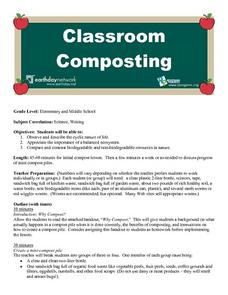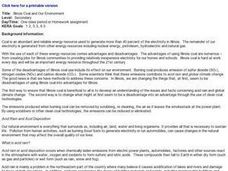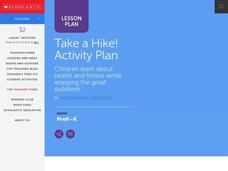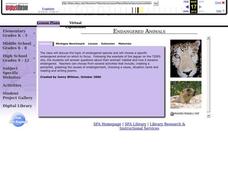Curated OER
The Edge of Home
Young scholars explain why some species of plants and animals occur in more than one area. They watch as the teacher puts an overlapping circles on the chalkboard, students are asked to predict what kinds of things they would expect to...
Curated OER
The Trouble with Crayfish
Fourth graders compare an ecosystem before and after they introduce crayfish to that ecosystem. In this ecosystem lesson plan, 4th graders see what happens when you introduce a non native animal to a habitat. Students then make...
Curated OER
Madagascar Adventure
Middle schoolers develop photo essays on Madagascar's environmental challenges. In groups, students research and develop photo essay slide shows to explore the issues of balancing the needs of Madagascar's human population with those of...
Curated OER
Classroom Composting
Students discover the benefits of composting. They identify the steps of decomposition as well. They are read a book and discuss what items decompose.
Curated OER
Kentucky Coal and Our Environment
Students read and discuss the article in reference to the environmental issues of acid rain and global climate change in relation to Kentucky coal. They then answer questions that are related to the article that they read.
Curated OER
Illinois Coal and Our Environment
Students read and discuss the important environmental issues of acid rain and global climate change in relation to Illinois coal. According to the National Acid Precipitation Assessment Program, acid rain has had minimal effects on our...
Curated OER
Images of Our Changing Earth
Students identify and explain that remote sensing can detect changes on the Earth's surface that occur over time, and name at least three: urbanization, deforestation, and succession. They select a global change issue to investigate and...
Curated OER
Take a Hike!
Students explore the benefits of staying active by going on a hike. In this physical education lesson, students discuss the concept of a hike, where a good place to hike is and what types of foods are necessary to stay nourished....
Curated OER
Habitat Hopscotch
Students analyze different habitats. In this habitat lesson, students evaluate what animals need in their habitats. Students participate in the game Habitat Hopscotch.
Curated OER
It's Up In the Air
Students examine a variety of tools that are used to collect scientific data. They conduct an experiment that reveals what type of particles is in the air at their school. Students report on their findings.
Curated OER
Fan 3: Sort and Color!
Students explore the concept of recycling. In this environmental stewardship lesson, students discover how to recycle and compost. Students complete an activity that requires them to sort recyclable items.
Curated OER
Paleoecology Using "Fossilized" Owl Pellets
Students study the differences in anatomy to help identify different species and use a dichotomous key to identify what the owls were eating. In this investigative lesson students dissect owl pellets to identify the species eaten...
Curated OER
Environmental Impact
Students analyze a 20th century photograph of a Los Angeles landscape and examine the population expansion of L.A. They discuss the principles of design, complete a worksheet, and write a research paper on overpopulation in Los Angeles.
Curated OER
Data, Data, Everywhere... and What Am I To Think?
Learners demonstrate good random sampling techniques for data collection, select and develop graphic presentations of data and analyze the data to solve a problem presented.
Curated OER
Buzzing is BEE-lieving
Young scholars investigate insects. In this insect lesson, students explore various insect models and identify the characteristics of each. Young scholars observe insects outside and tally how many insects they observe.
Curated OER
Cross Out Secondhand Smoke
After reading a public health article, high schoolers identify groups that are at risk from secondhand smoke and what benefits have come from reduction of smoking in public places. The article isn't accessible via the link, but can...
Curated OER
Endangered Animals
Students listen to a teacher led lecture on jaguars, their habitats, and how they became endangered. Using a specified web site, they choose an endangered animal to research. After gathering information, students participate in...
Curated OER
Conservation in Small Spaces: Conservation
Students define conservation, identify actions that conserve habitat and those that reduce habitat, and generate ideas about how one can practice conservation in everyday life.
Curated OER
The New Explorers: Environmental Swat Team
Pupils follow scientists into the dry forest of Bolivia as they track and record the different species of mammals, birds, insects and plants that would be lost if the forests disappear.
Curated OER
Environmental Education
Second graders examine how their choices affect the environment. They identify different types of pollution and its source. They ask questions to end the lesson.
Curated OER
What's The Level?
Learners examine the movement of the water table and saturation zones. They describe the movements of the water table and locate the saturation zones. Students identify the function of each saturation zone. They develop a model of the...
Curated OER
MOBILITY, Traveling Lightly: What’s My Footprint?
Young scholars calculate their carbon footprint. In this environmental technology lesson, students listen to a lecture on climate change. Young scholars brainstorm solutions to reduce environmental impact based on travel options....
Curated OER
Soil Science Study
Learners complete an activity by looking and gathering data on plants and soils.
Curated OER
Environmental Issues in South Carolina
Students research governmental agencies that deal with the environment and chart aspects about each agency. They role-play a city council meeting to address the topic of building a waste to energy facility.

























